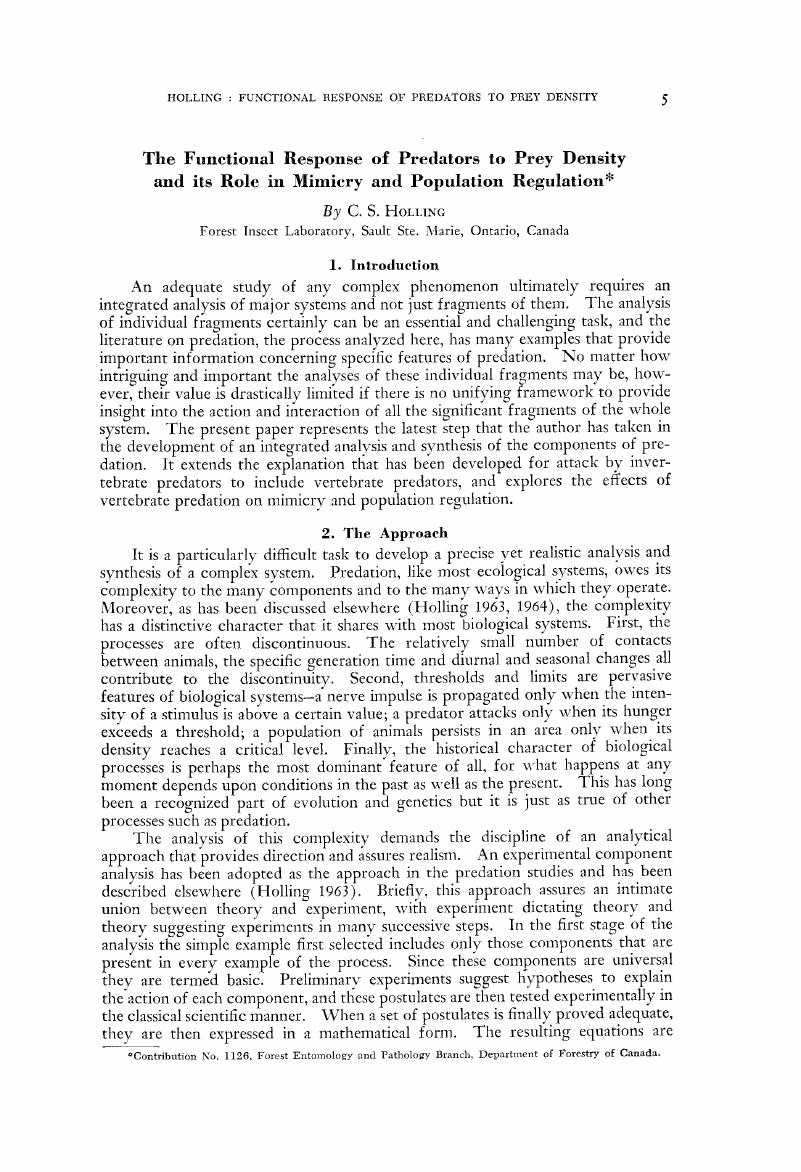Crossref Citations
This article has been cited by the following publications. This list is generated based on data provided by Crossref.
Holling, Crawford S.
1966.
Systems Analysis in Ecology.
p.
195.
MURTON, R.K.
1968.
The Problems of Birds As Pests.
p.
157.
Griffiths, K. J.
and
Holling, C. S.
1969.
A COMPETITION SUBMODEL FOR PARASITES AND PREDATORS.
The Canadian Entomologist,
Vol. 101,
Issue. 8,
p.
785.
Greenwood, J J D
1969.
Apostatic selection and population density.
Heredity,
Vol. 24,
Issue. 1,
p.
157.
Huffaker, C. B.
and
Kennett, C. E.
1969.
SOME ASPECTS OF ASSESSING EFFICIENCY OF NATURAL ENEMIES.
The Canadian Entomologist,
Vol. 101,
Issue. 4,
p.
425.
Silliman, Ralph P.
1969.
Population Models and Test Populations as Research Tools.
BioScience,
Vol. 19,
Issue. 6,
p.
524.
Glass, Norman R.
1970.
A COMPARISON OF TWO MODELS OF THE FUNCTIONAL RESPONSE WITH EMPHASIS ON PARAMETER ESTIMATION PROCEDURES.
The Canadian Entomologist,
Vol. 102,
Issue. 9,
p.
1094.
Alcock, John
1970.
Punishment levels and the response of black-capped chickadees (Parus atricapillus) to three kinds of artificial seeds.
Animal Behaviour,
Vol. 18,
Issue. ,
p.
592.
Sandness, J. N.
and
McMurtry, J. A.
1970.
FUNCTIONAL RESPONSE OF THREE SPECIES OF PHYTOSEIIDAE (ACARINA) TO PREY DENSITY.
The Canadian Entomologist,
Vol. 102,
Issue. 6,
p.
692.
Wilbert, Hubert
1970.
Feind-Beute-Systeme in kybernetischer Sicht.
Oecologia,
Vol. 5,
Issue. 4,
p.
347.
Alcock, John
1970.
Punishment levels and the response of white-throated sparrows (Zonotrichia albicollis) to three kinds of artificial models and mimics.
Animal Behaviour,
Vol. 18,
Issue. ,
p.
733.
Huffaker, C. B.
van de Vrie, M.
and
McMurtry, J. A.
1970.
Ecology of tetranychid mites and their natural enemies: A review: II. Tetranychid populations and their possible control by predators: An evaluation.
Hilgardia,
Vol. 40,
Issue. 11,
p.
391.
Dixon, Kenneth R.
and
Cornwell, George W.
1970.
A mathematical model for predator and prey populations.
Population Ecology,
Vol. 12,
Issue. 2,
p.
127.
Meats, A.
1971.
The relative importance to population increase of fluctuations in mortality, fecundity and the time variables of the reproductive schedule.
Oecologia,
Vol. 6,
Issue. 3,
p.
223.
LASSITER, RAY R.
and
HAYNE, DON W.
1971.
Systems Analysis and Simulation in Ecology.
p.
367.
Levin, Donald A.
1971.
THE ORIGIN OF REPRODUCTIVE ISOLATING MECHANISMS IN FLOWERING PLANTS.
TAXON,
Vol. 20,
Issue. 1,
p.
91.
LAWTON, J. H.
1971.
Maximum and actual field feeding‐rates in larvae of the damselfly Pyrrhosoma nymphula (Sulzer) (Odonata: Zygoptera).
Freshwater Biology,
Vol. 1,
Issue. 1,
p.
99.
RYKIEL, EDWARD J.
and
KUENZEL, NANCY T.
1971.
Systems Analysis and Simulation in Ecology.
p.
513.
Smith, James N.M.
and
Dawkins, Richard
1971.
The hunting behaviour of individual great tits in relation to spatial variations in their food density.
Animal Behaviour,
Vol. 19,
Issue. 4,
p.
695.
HUBBELL, STEPHEN P.
1971.
Systems Analysis and Simulation in Ecology.
p.
269.



